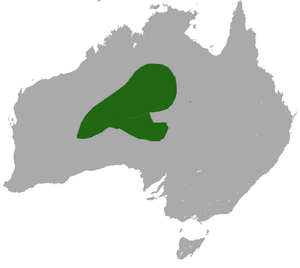Fat-tailed false antechinus facts for kids
Quick facts for kids Fat-tailed false antechinus |
|
|---|---|
| Conservation status | |
| Scientific classification | |
| Genus: |
Pseudantechinus
|
| Species: |
macdonnellensis
|
 |
|
| Fat-tailed false antechinus range | |
The fat-tailed false antechinus (scientific name: Pseudantechinus macdonnellensis) is a small, mouse-like marsupial. It's also known as the fat-tailed pseudantechinus or red-eared antechinus. This animal belongs to a group called Dasyuromorphia, which includes many Australian marsupials like quolls and Tasmanian devils. You can find it living in western and central Australia.
Contents
About the Fat-tailed False Antechinus
The fat-tailed false antechinus is a medium-sized marsupial. It usually weighs between 18 and 33 grams. These animals can live for about seven years. Scientists believe there are many of them, and they often live in protected areas. This means they are not currently considered an endangered species.
This animal is part of the Dasyuridae family. The second part of its scientific name, macdonnellensis, comes from the MacDonnell Ranges. This is a mountain range near Alice Springs in Australia, where the animal was first found.
Scientific Discovery
The fat-tailed false antechinus was first described in 1896. A scientist named Sir Walter Baldwin Spencer was the first to officially name it. He first placed it in a different group of animals. For a long time, it was thought to be part of the Antechinus group.
What Does It Look Like?
The fat-tailed false antechinus is about 9.5 to 10.5 centimeters (about 4 inches) long. Its tail is about 7.5 to 8.5 centimeters (about 3 inches) long. It usually weighs between 20 and 45 grams.
One special thing about this animal is its carrot-shaped tail. This tail can swell up with fat, which acts like a food reserve. This helps the antechinus survive when food is hard to find. Its fur is a grey-brown color.
Where Do They Live?
You can often find the fat-tailed false antechinus in rocky areas of Central Australia. They also live across South Australia, the Northern Territory, and Western Australia. These animals prefer rocky slopes and plains.
What Do They Eat?
The fat-tailed false antechinus is an insectivore. This means it mainly eats insects. Its diet includes beetles, grasshoppers, and termites. As mentioned, a unique feature is its ability to store fat in its tail. This happens when there is plenty of food available.
How They Survive: Torpor
In winter, many fat-tailed false antechinus go into a special state called torpor. This is like a mini-hibernation. They usually enter torpor after midnight while hiding in rock crevices. They stay there until the sun comes up.
In the morning, even while still in torpor, they move to sunny spots. They bask in the sun for the rest of the day. This daily torpor helps them save about 30% of their energy. It allows them to live and reproduce in tough environments. They also go into torpor if they are very stressed and don't have enough energy.
Reproduction and Life Cycle
Both male and female fat-tailed false antechinus become ready to have babies at about 350 days old. A female's pregnancy, called gestation, lasts about 43 days. She usually gives birth to one litter of about six young. They typically have one litter per year.
See also
 In Spanish: Falso antequino coligrueso para niños
In Spanish: Falso antequino coligrueso para niños


